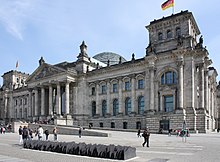Ernst Schneppenhorst
Ernst Wilhelm Schneppenhorst (born April 19, 1881 in Krefeld , † April 23 or 24, 1945 in Berlin ) was a German trade unionist, social democratic politician and resistance fighter against National Socialism.
Life
After five years of traveling, the trained carpenter lived in Nuremberg , where he worked from 1906 to 1918 as managing director of the German Association of Woodworkers . As a member of the SPD , he was chairman of the Nuremberg sub-district and from 1912 to 1920 a member of the Bavarian state parliament .
From November 1918 to March 1919 he was a government representative and head of the General Command of the III. Bavarian Army Corps in Nuremberg. During the Munich Soviet Republic , Schneppenhorst was appointed to the cabinet of Bavarian Prime Minister Johannes Hoffmann as Minister for Military Affairs from March 18 to August 22, 1919 . In 1921 he founded an optician's shop in Nuremberg.
From 1932 to 1933 Schneppenhorst was the Bavarian chairman of the Iron Front and represented Franconia as an SPD member in the Reichstag . He was particularly involved in the fight against the National Socialists . After the seizure of power by the Nazis, he went into hiding first. He later started making beer taps. Wilhelm Leuschner took over the management of this company in 1936 . In 1937 Schneppenhorst was imprisoned for one year. In the following years he was involved in building union-related resistance groups around Leuschner.
In 1939 he was imprisoned as part of the special war campaign . After the failed assassination attempt on Adolf Hitler on July 20, 1944 , he was arrested again in August as part of the Grid Action and was taken to the Lehrter Strasse prison in Berlin .
On the night of April 23 to 24, 1945, Ernst Schneppenhorst was fetched from prison together with Karl Ludwig Freiherr von und zu Guttenberg and Albrecht Graf von Bernstorff by a special command of the Reich Main Security Office and murdered.
Honors
The Schneppenhorstweg bears his name near the Plötzensee execution site . In Berlin, one of the 96 memorial plaques for members of the Reichstag murdered by the National Socialists has also been commemorating him since 1992 near the Reichstag .
Schneppenhorststrasse was also named in Nuremberg and Hanover.
See also
literature
- Johannes Merz: Schneppenhorst, Ernst. In: New German Biography (NDB). Volume 23, Duncker & Humblot, Berlin 2007, ISBN 978-3-428-11204-3 , p. 321 f. ( Digitized version ).
- Martin Schumacher (Hrsg.): MdR The Reichstag members of the Weimar Republic in the time of National Socialism. Political persecution, emigration and expatriation, 1933–1945. A biographical documentation . 3rd, considerably expanded and revised edition. Droste, Düsseldorf 1994, ISBN 3-7700-5183-1 .
- Ernst Schneppenhorst . In: Franz Osterroth : Biographical Lexicon of Socialism . Deceased personalities . Vol. 1. JHW Dietz Nachf., Hanover 1960, pp. 268-269.
Web links
- Literature by and about Ernst Schneppenhorst in the catalog of the German National Library
- Ernst Schneppenhorst in the database of members of the Reichstag
- Short biography of the German Resistance Memorial Center
- Joachim Lilla : Schneppenhorst, Ernst. In: ders .: Minister of State, senior administrative officials and (NS) officials in Bavaria from 1918 to 1945 (October 9, 2012).
Individual evidence
- ^ Bernhard Löffler, Cabinet Hoffmann II, 1919/20, in: Historisches Lexikon Bayerns
- ^ Reichstag handbook
- ↑ Schneppenhorstweg. In: Street name lexicon of the Luisenstädtischer Bildungsverein (near Kaupert )
| personal data | |
|---|---|
| SURNAME | Schneppenhorst, Ernst |
| ALTERNATIVE NAMES | Schneppenhorst, Ernst Wilhelm |
| BRIEF DESCRIPTION | German politician (SPD), MdR, trade unionist, resistance fighter |
| DATE OF BIRTH | April 19, 1881 |
| PLACE OF BIRTH | Krefeld |
| DATE OF DEATH | April 24, 1945 |
| Place of death | Berlin |

